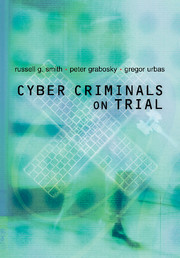Book contents
- Frontmatter
- Contents
- List of figures and tables
- Acknowledgments
- Preface
- Abbreviations
- Currency exchange rates
- Chapter One Introduction
- Chapter Two Defining and Measuring Cyber Crime
- Chapter Three The Prosecutor as Gatekeeper
- Chapter Four Cross-Border Issues
- Chapter Five Strategies of Cyber Crime Litigation
- Chapter Six The Quest for Harmonisation of Cyber Crime Laws
- Chapter Seven Judicial Punishment in Cyberspace
- Chapter Eight Sentencing Cyber Criminals
- Chapter Nine Conclusions
- References
- Appendix A Case Summaries 1972–2003
- Appendix B Selected Legislative Summaries
- Index
Chapter Seven - Judicial Punishment in Cyberspace
Published online by Cambridge University Press: 22 September 2009
- Frontmatter
- Contents
- List of figures and tables
- Acknowledgments
- Preface
- Abbreviations
- Currency exchange rates
- Chapter One Introduction
- Chapter Two Defining and Measuring Cyber Crime
- Chapter Three The Prosecutor as Gatekeeper
- Chapter Four Cross-Border Issues
- Chapter Five Strategies of Cyber Crime Litigation
- Chapter Six The Quest for Harmonisation of Cyber Crime Laws
- Chapter Seven Judicial Punishment in Cyberspace
- Chapter Eight Sentencing Cyber Criminals
- Chapter Nine Conclusions
- References
- Appendix A Case Summaries 1972–2003
- Appendix B Selected Legislative Summaries
- Index
Summary
The Definition of Judicial Punishment
Grotius, the seventeenth-century jurist and philosopher of law, defined punishment as ‘the infliction of an ill suffered for an ill done’. This definition contains the four essential elements of punishment:
the deed complained of and the punishment inflicted are linked;
punishments are intentionally inflicted for a reason;
the individual who is punished is answerable for his or her actions; and
the infliction of punishment is a socially regulated activity.
Judicial punishment, which is controlled by the state, should also be distinguished from punishments which are inflicted informally, such as by parents on children (see generally Hart 1968, Walker 1991 and Flew 1969).
Punishments differ from acts of personal revenge in that they are administered by the state and are subject to rules as to consistency and appropriateness. Certain categories of people are exempt from judicial punishment, namely, children under certain specified age limits (usually ten years of age); slightly older children (usually between ten and fourteen years of age) who do not know that what they did was wrong; and individuals who are unfit to plead or found to be legally insane. These rules exist to protect those whom society determines to be not legally responsible for their actions.
In cyberspace, however, the imposition of judicial punishment poses some difficulties, particularly where young offenders are concerned. On occasions they may have inflicted enormous damage, sometimes extending across the globe, as in the case of the creation and release of malicious code.
- Type
- Chapter
- Information
- Cyber Criminals on Trial , pp. 106 - 123Publisher: Cambridge University PressPrint publication year: 2004



